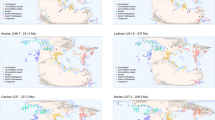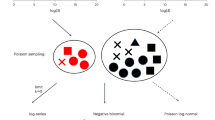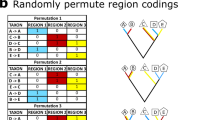Abstract
Measuring the completeness of the fossil record is essential to understanding evolution over long timescales, particularly when comparing evolutionary patterns among biological groups with different preservational properties. Completeness measures have been presented for various groups based on gaps in the stratigraphic ranges of fossil taxa1,2 and on hypothetical lineages implied by estimated evolutionary trees3,4,5. Here we present and compare quantitative, widely applicable absolute measures of completeness at two taxonomic levels for a broader sample of higher taxa of marine animals than has previously been available. We provide an estimate of the probability of genus preservation per stratigraphic interval6,7, and determine the proportion of living families with some fossil record8,9,10. The two completeness measures use very different data and calculations. The probability of genus preservation depends almost entirely on the Palaeozoic and Mesozoic records, whereas the proportion of living families with a fossil record is influenced largely by Cenozoic data. These measurements are nonetheless highly correlated, with outliers quite explicable, and we find that completeness is rather high for many animal groups.
This is a preview of subscription content, access via your institution
Access options
Subscribe to this journal
Receive 51 print issues and online access
$199.00 per year
only $3.90 per issue
Buy this article
- Purchase on Springer Link
- Instant access to full article PDF
Prices may be subject to local taxes which are calculated during checkout



Similar content being viewed by others
References
Paul, C. R. C. in Problems of Phylogenetic Reconstruction (eds Joysey, K. A. & Friday, A. E.) 75–117 (Academic, London, (1982).
Solow, A. R. & Smith, W. On fossil preservation and the stratigraphic ranges of taxa. Paleobiology 23, 271–277 (1997).
Benton, M. J. & Storrs, G. W. Testing the quality of the fossil record: paleontological knowledge is improving. Geology 22, 111–114 (1994).
Benton, M. J. & Simms, M. J. Testing the marine and continental fossil records. Geology 23, 601–604 (1995).
Benton, M. J. & Hitchin, R. Testing the quality of the fossil record by groups and by major habitats. Histor. Biol. 12, 111–157 (1996).
Foote, M. & Raup, D. M. Fossil preservation and the stratigraphic ranges of taxa. Paleobiology 22, 121–140 (1996).
Foote, M. Estimating taxonomic durations and preservation probability. Paleobiology 23, 278–300 (1997).
Schopf, T. J. M. Fossilization potential of an intertidal fauna: Friday Harbor, Washington. Paleobiology 4, 261–270 (1978).
Raup, D. M. Biases in the fossil record of species and genera. Bull. Carnegie Mus. Nat. Hist. 13, 85–91 (1979).
Valentine, J. W. How good was the fossil record? Clues from the Californian Pleistocene. Paleobiology 15, 83–94 (1989).
Wills, M. A. Annelid, in The Fossil Record Vol. 2(ed. Benton, M. J.) 271–278 (Chapman & Hall, London, (1993).
Zangerl, R. in Handbook of Paleoichthyology Vol. 3A(ed. Schultze, H.-P.) 1–115 (Gustav Fischer, Stuttgart, (1981).
Cappetta, H. in Handbook of Paleoichthyology Vol. 3B(ed. Schultze, H.-P.) 1–193 (Gustav Fischer, Stuttgart, (1987).
Patterson, C. & Smith, A. B. Is the periodicity of extinction a taxonomic artefact? Nature 330, 248–251 (1987).
Marshall, C. R. & Ward, P. D. Sudden and gradual molluscan extinctions in the latest Cretaceous of western European Tethys. Science 274, 1360–1363 (1996).
Signor, P. W. & Lipps, J. H. Sampling bias, gradual extinction patterns, and catastrophes in the fossil record. Geol. Soc. Amer. Spec. Pap. 190, 291–296 (1982).
Fortey, R. A. & Jefferies, R. P. S. in Problems of Phylogenetic Reconstruction (eds Joysey, K. A. & Friday, A. E.) 197–234 (Academic, London, (1982).
Wagner, P. J. Stratigraphic tests of cladistic hypotheses. Paleobiology 21, 153–178 (1995).
Fisher, D. C. in Interpreting the Hierarchy of Nature: From Systematic Patterns to Evolutionary Process Theories (eds Grande, L. & Rieppel, O.) 133–171 (Academic, San Diego, (1994).
Foote, M. On the probability of ancestors in the fossil record. Paleobiology 22, 141–151 (1996).
Paul, C. R. C. The adequacy of the fossil record reconsidered. Spec. Pap. Palaeontol. 33, 7–16 (1985).
Norell, M. A. & Novacek, M. J. The fossil record and evolution: comparing cladistic and paleontologic evidence for vertebrate history. Science 255, 1690–1693 (1992).
Hitchin, R. & Benton, M. J. Congruence between parsimony and stratigraphy: comparisons of three indices. Paleobiology 23, 20–32 (1997).
Sepkoski, J. J. J in Global Events and Event Stratigraphy (ed. Walliser, O.) 35–52 (Springer, Berlin, (1996).
Harland, W. B. et al. A Geologic Time Scale 1989 (Cambridge Univ. Press, (1990).
Sepkoski, J. J. J Biodiversity: past, present, and future. J. Paleontol. 71, 533–539 (1997).
Sepkoski, J. J. J Rates of speciation in the fossil record. Phil. Trans. R. Soc. Lond. B 353, 315–326 (1998).
Sepkoski, J. J. J Acompendium of fossil marine animal families, 2nd edition. Milwaukee Publ. Mus. Contrib. Biol. Geol. 83, 1–156 (1992).
Benton, M. J. (ed.) The Fossil Record Vol. 2(Chapman & Hall, London, (1993).
Parker, S. P. (ed.) Synopsis and Classification of Living Organisms (McGraw-Hill, New York, (1982).
Acknowledgements
We thank E. G. Hunt, A. McGowan, A. I. Miller, and P. J. Wagner for comments. This work was supported by the US National Aeronautics and Space Administration and the US National Science Foundation.
Author information
Authors and Affiliations
Corresponding author
Rights and permissions
About this article
Cite this article
Foote, M., Sepkoski, J. Absolute measures of the completeness of the fossil record. Nature 398, 415–417 (1999). https://doi.org/10.1038/18872
Received:
Accepted:
Issue Date:
DOI: https://doi.org/10.1038/18872
This article is cited by
-
Concept drift over geological times: predictive modeling baselines for analyzing the mammalian fossil record
Data Mining and Knowledge Discovery (2019)
-
Parallel evolution controlled by adaptation and covariation in ammonoid cephalopods
BMC Evolutionary Biology (2011)
-
Strong mitochondrial DNA support for a Cretaceous origin of modern avian lineages
BMC Biology (2008)
-
Molecular clocks: four decades of evolution
Nature Reviews Genetics (2005)
-
Using the fossil record to estimate the age of the last common ancestor of extant primates
Nature (2002)
Comments
By submitting a comment you agree to abide by our Terms and Community Guidelines. If you find something abusive or that does not comply with our terms or guidelines please flag it as inappropriate.



